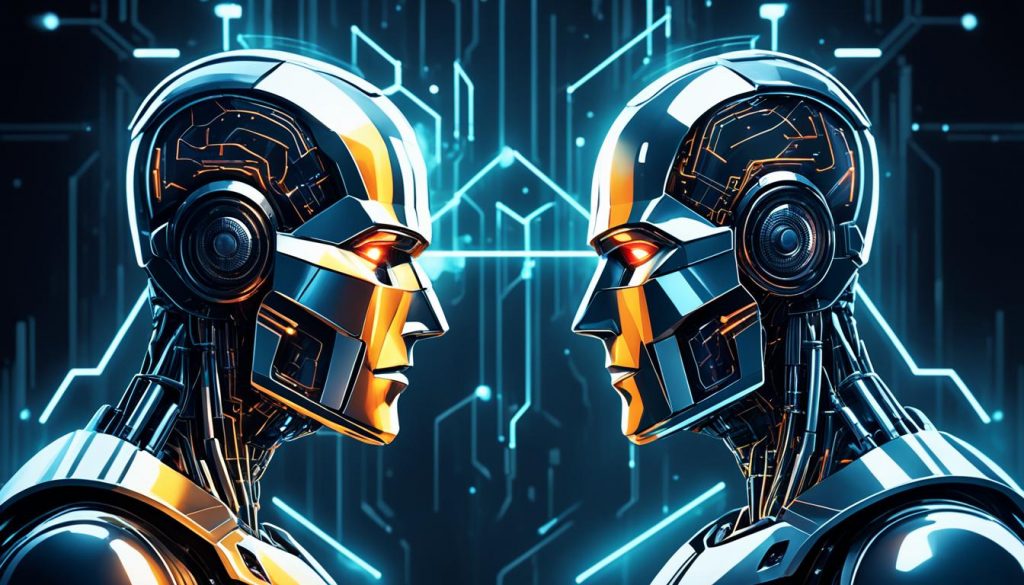Welcome to my article where we will delve into the fascinating world of AI language models and explore the differences between AutoGPT and ChatGPT. As the demand for natural language processing continues to grow, it’s crucial to understand these revolutionary models, their capabilities in autoregressive generation, the underlying transformer architecture, and the machine learning algorithms powering them.
AutoGPT and ChatGPT have taken the AI landscape by storm, offering unique features and applications. By understanding the distinctions between these two powerful language models, users can effectively harness their power for various tasks and unlock a world of possibilities.
In this article, we will unravel the capabilities and limitations of both AutoGPT and ChatGPT, providing you with valuable insights into their use cases and helping you make informed decisions. So, let’s dive in and discover the exciting world of AutoGPT and ChatGPT!
An Overview of AutoGPT
AutoGPT is an autonomous AI language model that utilizes GPT-3.5 technology. It is designed to perform automated tasks and is capable of conducting real-time searches, extracting data, and generating scripts.
Unlike ChatGPT, AutoGPT can access up-to-date information from the web, making it a versatile tool for users who need current and relevant data for their tasks.
By leveraging AutoGPT’s capabilities, users can streamline their workflow and improve efficiency in various applications that require automation and data extraction.
With AutoGPT’s powerful AI language model, users can effortlessly handle tasks that involve real-time searches, data extraction, and script generation.
Automated tasks such as gathering the latest market data, extracting relevant information from web pages, or generating scripts for repetitive actions are made easier with AutoGPT.
Whether it’s conducting research, monitoring trends, or automating data analysis, AutoGPT offers a range of possibilities for users seeking efficient and accurate AI-driven solutions.
In the next section, we will explore ChatGPT, another AI language model that specializes in conversational interactions and natural language understanding.
ChatGPT: A Conversational AI Agent
ChatGPT, developed by OpenAI, is an exceptional AI language model designed specifically for conversational interactions. It is capable of simulating human-like text conversations and generating responses that are coherent and contextually relevant. Unlike AutoGPT, which focuses on automated tasks, ChatGPT excels in natural language understanding and engaging in interactive conversation.
By leveraging the power of ChatGPT, users can experience meaningful and interactive exchanges with an AI assistant. Whether you need assistance with general inquiries or engaging in engaging conversations, ChatGPT’s advanced conversational abilities make it a valuable tool.

With ChatGPT, the AI assistant is equipped with the ability to understand and process natural language, enabling seamless and contextually relevant interactions. Whether you need to ask questions, seek explanations, or simply engage in small talk, ChatGPT is designed to deliver a human-like conversational experience.
So, if you’re looking for an AI agent that excels in conversational interactions, ChatGPT is the ideal choice. Its ability to comprehend pre-existing information and generate coherent responses ensures that your conversations are engaging, informative, and enjoyable.
Comparing AutoGPT and ChatGPT Capabilities
When comparing AutoGPT and ChatGPT, it is essential to focus on their specific capabilities. AutoGPT excels in tasks that require automated processing, such as real-time searches and data extraction. Leveraging its advanced natural language processing techniques, AutoGPT is a powerful tool for users seeking quick and accurate information retrieval.
On the other hand, ChatGPT shines in conversational interactions, providing contextually relevant responses based on pre-existing information. Utilizing its conversational agents and AI capabilities, ChatGPT can engage users in meaningful conversations, simulating human-like interactions with its conversational prowess.
Both AutoGPT and ChatGPT have their own unique strengths and use cases. AutoGPT proves to be invaluable for tasks that demand automated processing, offering efficient real-time searches and data extraction. In contrast, ChatGPT showcases its conversational abilities, delivering coherent and contextually relevant responses.
Ultimately, understanding the distinctions between AutoGPT and ChatGPT will help users determine which model is best suited for their specific needs. Whether it’s harnessing the power of automated tasks or engaging in interactive conversations, these AI language models provide a range of capabilities to enhance natural language processing.
To visually illustrate the strengths of AutoGPT and ChatGPT, take a look at the image below:
The Strengths and Limitations of AutoGPT and ChatGPT
When comparing AutoGPT and ChatGPT, it’s important to consider their respective strengths and limitations. Both AI language models have unique qualities that make them suitable for specific use cases.
AutoGPT’s Strengths
- Real-time searches: AutoGPT is adept at conducting real-time searches, providing users with up-to-date information for their tasks.
- Data extraction: With AutoGPT, users can efficiently extract relevant data from various sources, streamlining their workflow.
- Script generation: AutoGPT’s ability to generate scripts automates repetitive tasks, saving users time and effort.

AutoGPT’s Limitations
- Handling large volumes of data: AutoGPT may face challenges when processing extensive datasets, which could impact its performance.
- Unavailable scripts: If specific scripts or templates are not available, AutoGPT’s script generation capabilities might be limited.
ChatGPT’s Strengths
- Conversational capabilities: ChatGPT excels in engaging and interactive conversations, simulating human-like text responses.
- Natural language understanding: With ChatGPT, users can have meaningful interactions and receive contextually relevant information.
ChatGPT’s Limitations
- Verbose responses: ChatGPT may produce verbose or excessively lengthy responses, which can affect the overall conversational experience.
- Off-topic responses: In some cases, ChatGPT might provide responses that deviate from the intended topic or context.
By understanding the strengths and limitations of both AutoGPT and ChatGPT, users can make informed decisions regarding the AI language model that best suits their specific needs.
Conclusion
The battle between AutoGPT and ChatGPT showcases the advancements in AI language models and their applications. These AI language models, powered by natural language processing, have transformed the way we interact with machines and leverage their capabilities.
AutoGPT stands out in performing automated tasks and accessing up-to-date information. It is an ideal choice for tasks that require real-time data retrieval and automation. On the other hand, ChatGPT excels in conversational interactions, providing pre-existing information and generating human-like responses. It is well-suited for general knowledge inquiries and engaging in meaningful conversations.
Choosing between AutoGPT and ChatGPT depends on the specific requirements of the user. If you need real-time data and automation, AutoGPT is the way to go. However, if you seek engaging conversations and access to pre-existing information, ChatGPT is the preferred option.
Prompt engineering techniques can further optimize the performance of both AutoGPT and ChatGPT. By fine-tuning the chat prompts and utilizing prompt engineering strategies, users can customize the outputs of these AI language models to meet their specific needs, ensuring better results and a more tailored experience.
In conclusion, understanding the capabilities and limitations of AutoGPT and ChatGPT is crucial for effectively harnessing the power of AI language models. With the advancements in natural language processing and prompt engineering, these models continue to evolve and provide endless possibilities for various applications.
